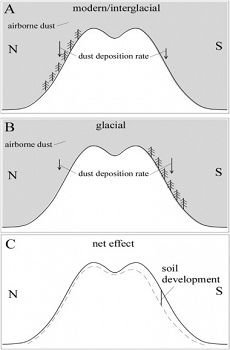Rasmussen et al., 2017
Coevolution of soil and topography across a semiarid cinder cone chronosequence
Rasmussen C., McGuire L., Dhakal P., Pelletier J.D. (2017)
CATENA 156: 338-352
-
Catalina-Jemez, INVESTIGATOR
-
Catalina-Jemez, INVESTIGATOR
Plain English Summary
- Document coevolution of soils and landscapes across a cinder cone chronosequence
- South-facing hillslopes accumulated more dust despite higher rates of erosion.
- Dust accumulation attributed to vegetation cover during glacial climates
- Greater dust on south-facing slopes associated with argillic horizon formation
- Dust accumulation fosters in situ weathering of the basalt cinders
Abstract
Schematic diagram of slope-aspect differences in vegetation cover and soil development on cinder cones in Arizona. During interglacial periods vegetation cover and canopy height is greatest on north-facing slopes. Given the correlation between vegetation cover and dust deposition rates, we infer that dust deposition rates are also highest on north-facing slopes during interglacials. During glacial conditions the situation is reversed, with the highest vegetation cover and dust deposition rates on south-facing slopes. Given that climatic conditions are closest to full-glacial conditions over the Quaternary, our proposed model predicts that cinder cones of at least 50 kyr in age have enhanced soil development on south-facing slopes.
Soil evolution and the development of surface and subsurface diagnostic horizons affects hydrologic partitioning of precipitation to infiltration and runoff, and the vegetative carrying capacity of landscapes, all of which affect rates of hillslope erosion. Rates of erosion, in turn, feedback on soil development by removing or preserving soil horizons. This coevolution is difficult to investigate because landscape age and initial conditions are often poorly constrained. In this paper we investigated the coevolution of the soils and hillslope topography by exploiting differences in vegetation type and density as a function of slope aspect across a semiarid basaltic cinder cone chronosequence, spanning cone ages from 1.065 to 1000 kyr, in the San Francisco volcanic field (SFVF) of northern Arizona, USA. We document that soils on south-facing hillslopes exhibit systematically more aeolian-derived dust despite having higher rates of erosion. We attribute this to the fact that south-facing slopes likely had more dust-trapping vegetation cover during the glacial climates that dominated the Quaternary. The higher dust contents of soils on south-facing slopes was associated with formation of argillic horizons, lower saturated hydrologic conductivity and increased water holding capacity. Greater water retention, in turn, likely increased rates of erosion by bioturbation and freeze-thaw-driven creep in a positive feedback. Over time, dust accumulation at the hillslope point of inflection increased with age up to several hundred thousand years, then decreased with time as the cones degraded by erosion. Data suggest that approximately 200 kyr of time was required before the soils developed sufficient water-holding capacity to drive in situ weathering of the basalt cinders. These results further demonstrate the importance of feedbacks among soil development, hydrology, and geomorphology in the evolution of hillslopes.
Citation
Rasmussen C., McGuire L., Dhakal P., Pelletier J.D. (2017): Coevolution of soil and topography across a semiarid cinder cone chronosequence. CATENA 156: 338-352. DOI: 10.1016/j.catena.2017.04.025
 This Paper/Book acknowledges NSF CZO grant support.
This Paper/Book acknowledges NSF CZO grant support.
Explore Further



